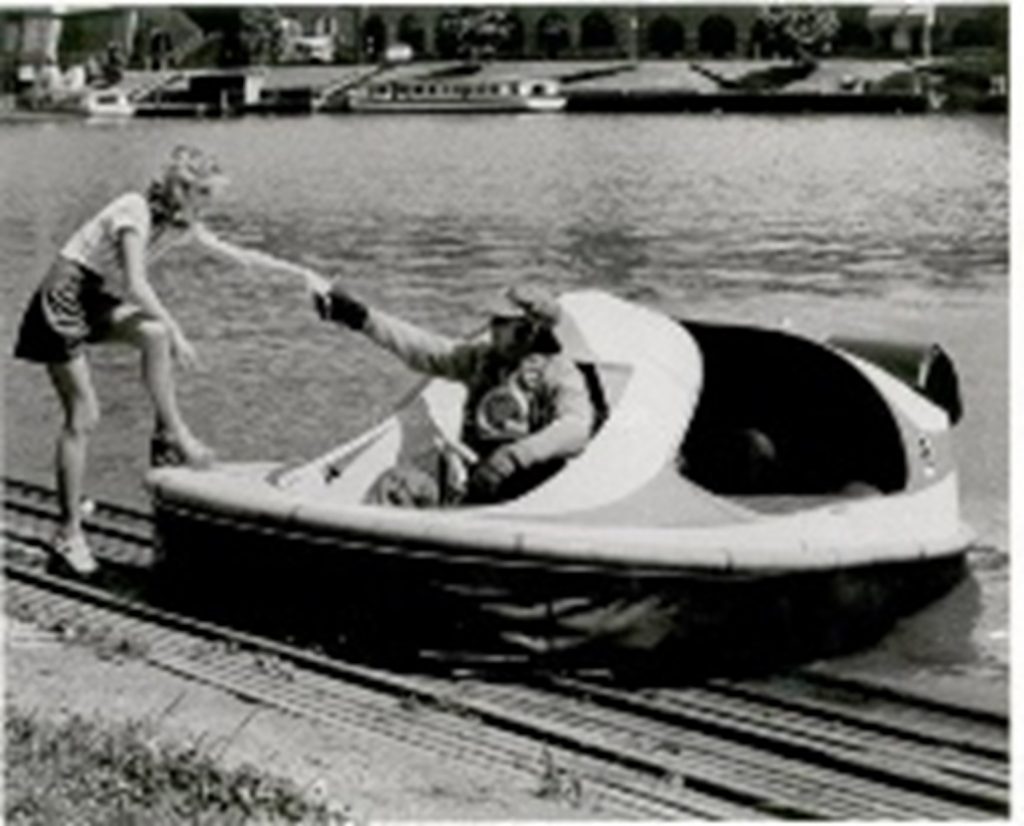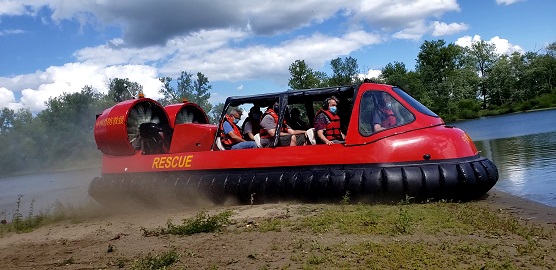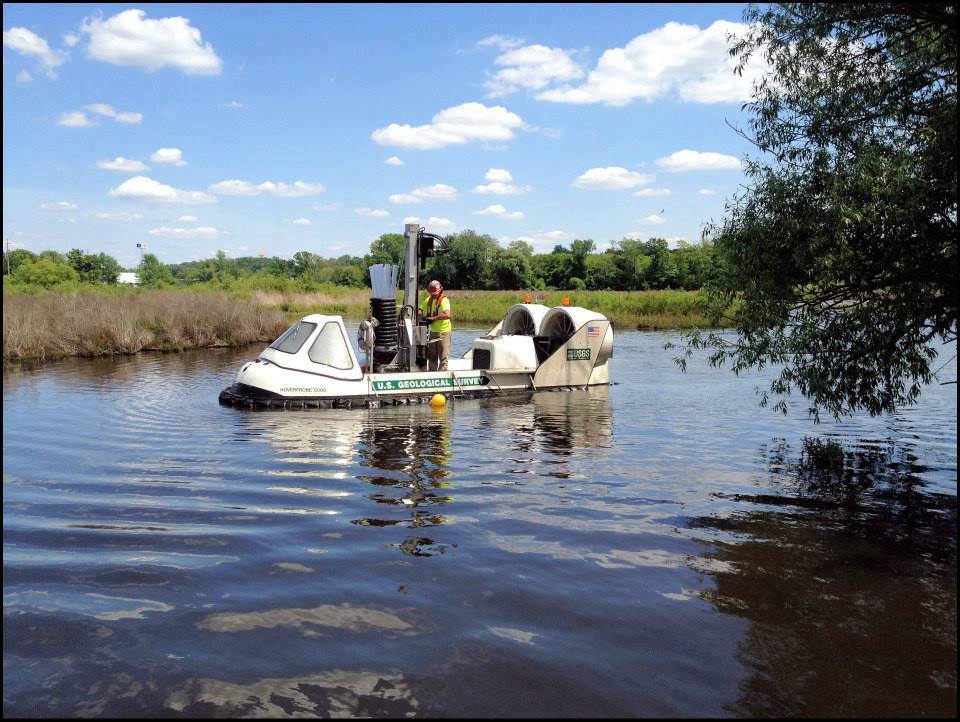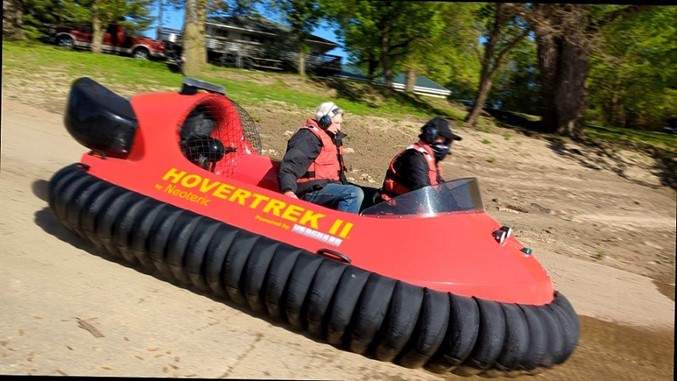The Early Days
Several cadets from the Royal Australian Air Force’s Air Training Corps became interested in Hovercraft during 1959. Led by Cadet Warrant Officer Chris Fitzgerald, they were known as “The Hovercraft Research Organization” Shortly after they became “Australian Air Cushion Vehicle Development (AACVD)”. By 1968 AACVD began developing a variety of unrelated products, such as outdoor furniture, and again changed its name to Neoteric Engineering Affiliates Pty Ltd and incorporated in Melbourne during 1973.
AACVD members were working as students in the Mechanical Engineering School at Melbourne University in 1962, when they were invited by the Canberra Branch of the Royal Aeronautical Society to participate in the World’s First GEM “Hovercraft Race”, Canberra 14th March 1964. The event was to commemorate the opening of Canberra’s Lake Burley Griffin.

Due to his activities in AACVD, Fitzgerald won a Rotary International Technical Training Award allowing him to travel the world and study Hovercraft. He spent all of 1969 and 70 visiting every Hovercraft project he could find across the globe. During these 2 years, he also studied Aeronautical Engineering at Farnborough Technical College in the UK, and spent 5 months on the Isle of Wight as an intern with The British Hovercraft Corporation (BHC). BHC was then the world’s foremost Hovercraft company.
Move to Terre Haute, Indiana
With the information gathered while travelling and from these two years of study, a new prototype was developed in Melbourne and patented by the group. To promote their developments, it was decided to move to the US in 1975 and settle in Terre Haute, Indiana. Registered in Indiana as Neoteric Inc and doing business as Neoteric Hovercraft Inc, the intent was to sell its designs, products, its light hovercraft manufacturing and marketing technology to an established manufacturer of comparable products. However in spite of their many attempts and best efforts Neoteric found little interest from any potential buyer.
This lack of interest was understood to be due to the general lack of awareness of hovercraft and their varied uses. Since hovercraft were and still are relatively unknown almost no market exists for selling its technology Neoteric decided if it were to benefit from all of its development work it would have to utilize its technology in-house by doing what it always tried to avert that was to set-up its own hovercraft manufacturing and marketing.
While this process was going on in Terre Haute Fitzgerald established the Hoverclub of America, in an effort to raise hovercraft awareness.



Establishment of The Hoverclub of America
While this process was going on in Terre Haute Fitzgerald established the Hoverclub of America, in an effort to raise hovercraft awareness.
With Neoteric’s financial support Fitzgerald registered the Hoverclub of America Inc in 1976 as a 501C3 Nonprofit Charity.
For more than 20 years Neoteric was responsible for organizing and managing the Club and organized all of the US national Rallies in Terre Haute Indiana. Membership grew to 600 and Fitzgerald organized two world Championship meets in Troy, Ohio 1989 and Terre Haute, Indiana in 2002.
Fitzgerald believes that supporting the Hoverclub was good for promoting Hovercraft and giving the fledgling industry one voice through its dedicated membership – a collection of people fascinated by the concept of hovering.
Growing the business
Funds for Neoteric came through occasional Hovercraft sales of its products in the early days. In this way, income generated was just sufficient to support the company while it continued developing, promoting and marketing a variety of different hovercraft models.
This business model is an extremely slow process taking much dedication and effort. Despite everything, the company managed to survive. In its 50 years, Neoteric has developed and manufactured 20 unique models and sold in excess of 1000 light hovercraft.
Neoteric hovercraft have been purchased by individuals for recreation, services for rescue, survey and other industrial purposes, and special models have been built for advertising and promotions.


Hovertechnics joins the group
In 2017, Neoteric purchased Hovertechnics, a Hovercraft manufacturing company in Michigan. The idea was to benefit from servicing Hovertechnics’ many clients with spare parts and by adding a 12-seat model to further Neoteric’s product line. it was contemplated that this acquisition might make Neoteric a more attractive acquisition for an interested enterprise.
Since Hovertechnics inception in 1982 1000 units have been built and sold. These craft are based on Bill Baker’s UK designs. Purchasing Hovertechnics has given Neoteric indirect access to these 1000 Hovercraft customers which it now supports technically and with spares.
Since joining the group the model range has been focussed and a revised V8 powered Hovertour 2000 and Hoverprobe 2000 for utility tasks has been developed


Personalized training
Presently, Neoteric continues to develop new and improved models as well as manufacture a range of 1-12 seat Hovercraft. The 4 and 6 seat models are their most popular sizes. They find recreation, rescue, commercial and military uses.
To foster hovercraft’s safety, functionality, versatility and awareness, the company has developed a pilot and maintenance training program, whereby a novice is subjected to rigorous instruction. Customers participate in training programs for as long as they choose. This training programme has proved specially valuable for fire and rescue services where several pilots may be needed that will then operate in extreme conditions of ice, fist running rivers, flooded areas etc – exactly the environment a hovercraft is so valuable!
Neoteric now have a team of expert trainers through the USA and beyond that can assist improving a client’s skills. Click on the image below to go to our training site.
Current Range and developments
Presently, Neoteric continues to develop new and improved models as well as manufacture a range of 1-12 seat Hovercraft. The 4 and 6 seat models are their most popular sizes. They find recreation, rescue, commercial and military uses.
With a continual emphasis on technology and manufacturing development, Neoteric has emerged as the world’s leading developer of light hovercraft. Presently in the works are several projects such as a Briggs and Stratton 40 hp powered craft. This machine reflects a return to the company’s original 4 cycle powered craft which were 46 hp 4 cycle VW engines. The Briggs powered machine is quiet, reliable and easy to pilot compared to other hovercraft in its class.

The group’s goal has always been to promote the awareness of hovercraft, their versatility and their usefulness by involving others in Neoteric’s creations, its software and manufacturing know-how. Uniquely situated for an amalgamation with an organization who already possesses International Marketing and expandable Manufacturing capability.
Any future partnership will lead to a broader market for its developed brand of product and will capitalize on their formative “brand”. The company is now focused on bringing its long-term objective to fruition.
For information on our privacy policy please click on the Button